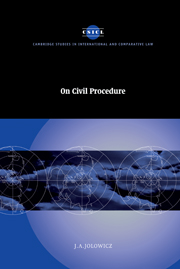Book contents
- Frontmatter
- Contents
- Preface
- List of abbreviations
- Introduction
- I The litigation process
- II Protection of diffuse, fragmented and collective interests
- III Procedural modes
- IV The parties and the judge
- V Recourse against judgments
- 14 Civil appeals in England and Wales
- 15 Appeal, cassation, amparo and all that: what and why?
- 16 Managing overload in appellate courts: ‘Western’ countries
- VI Procedural reform
- Index
- CAMBRIDGE STUIDES IN INTERNATIONAL AND COMPARATIVE LAW
15 - Appeal, cassation, amparo and all that: what and why?
from V - Recourse against judgments
Published online by Cambridge University Press: 18 December 2009
- Frontmatter
- Contents
- Preface
- List of abbreviations
- Introduction
- I The litigation process
- II Protection of diffuse, fragmented and collective interests
- III Procedural modes
- IV The parties and the judge
- V Recourse against judgments
- 14 Civil appeals in England and Wales
- 15 Appeal, cassation, amparo and all that: what and why?
- 16 Managing overload in appellate courts: ‘Western’ countries
- VI Procedural reform
- Index
- CAMBRIDGE STUIDES IN INTERNATIONAL AND COMPARATIVE LAW
Summary
Introduction
Generally speaking, the law governing recourse against judicial decisions recognises two categories of procedure, and the distinction between them is reflected by the use of two different words: appel, cassation; appello, cassazione; apdacion, casacián (or amparo-casacián); Berufung, Revision No such pairing exists, however, in English, which has only ’appeal’.
This does not mean that procedures which would be classified elsewhere as cassation rather than appeal did not and do not exist in the common law. On the contrary, until the major reforms of the nineteenth century, an appeal properly so-called existed in England only in the courts of Equity; in the courts of ‘common law’ the only forms of recourse available had far more in common with the cassation than with the appeal of other countries. What is more, while England itself substituted for those forms of recourse a procedure of appeal in the nineteenth century, reserving a procedure analogous to cassation for limited classes of case including, most importantly, recourse against the decisions of administrative authorities or tribunals, in the United States of America the older English forms of recourse - including what is actually now called an ‘appeal’ to a ‘Court of Appeals’ - have been developed rather than replaced: for the purposes of this chapter, therefore, the American appeal is treated as a form of cassation rather than of appeal.
- Type
- Chapter
- Information
- On Civil Procedure , pp. 299 - 327Publisher: Cambridge University PressPrint publication year: 2000
- 1
- Cited by



